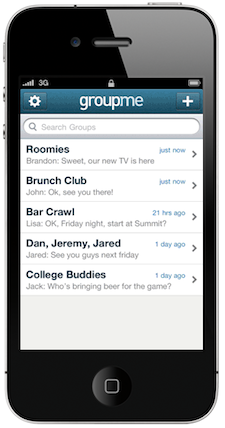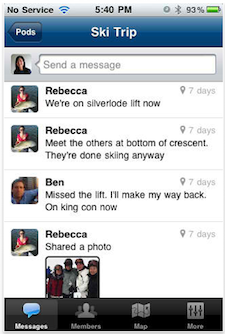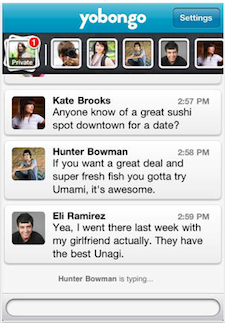 By now you’ve doubtless heard of the many group messaging startups looking to help multiple people keep in touch with each other — there’s been endless buzz about how these will likely be some of the breakout stars of SXSW. However, most of these companies do far more than just send texts to multiple people: some of them offer location sharing, conference calls, and other features. Here is a roundup of some of the major services and their feature sets to help you choose which one is best for you, just in time for SXSW.
By now you’ve doubtless heard of the many group messaging startups looking to help multiple people keep in touch with each other — there’s been endless buzz about how these will likely be some of the breakout stars of SXSW. However, most of these companies do far more than just send texts to multiple people: some of them offer location sharing, conference calls, and other features. Here is a roundup of some of the major services and their feature sets to help you choose which one is best for you, just in time for SXSW.
Groupme
Groupme is a group texting and conference calling service that originated at the 2010 TechCrunch Disrupt Hackathon, and has already received $11.5M in funding. Users can chat with or call multiple people at a time, by setting up a unique phone number that is shared with the members of the group. By texting or calling the number, groups of up to 25 people can share conversations. Users can also share photos with the group online, or through Android or iPhone Apps. Currently, Groupme users send about 1,000,000 text messages and make a few thousand conference calls each day.
It is possible to create short-term groups that expire after a certain amount of time if the group is created online, with the iPhone App, or with Google Voice. In the case that users change their minds and decide they’d rather have a long-term group, Groupme will send the creator a notice one hour before the group is set to expire, and the user can extend the time limit if necessary. However, Groupme says that they haven’t experienced heavy usage of their short-term groups.
Groupme can operate on any cell phone capable of sending and receiving text messages, and the service is free, though the text messaging rates of a user’s cell phone carrier do apply. Users can use #commands to manage the group and the members in it. (For example, #mute will stop messages from the group, and sending #help prompts a message that reminds you of other basic commands). There are no restrictions on the number of groups that a user can be a part of.
In preparation for SXSW, Groupme revamped their apps for iPhone and Android, providing users with the option of sending their messages through Push Notifications instead of SMS, saving them the costs of sending text messages (this also sends Groupme the cost of routing the messages). For these users with Android or iPhone apps, all of their group chats appear within the app itself rather than their SMS apps. Members of a group can also find each other’s locations on a map — a new feature for Groupme that Beluga and Fast Society already have. Users can also check into Foursquare locations directly from the Groupme app. Their more recent update, 2.1 More thing, further improves their iPhone and Android apps, allowing users to advertise their groups on Facebook or Twitter, where friends can request to join. And if one creates an SXSW group, special locations will show up on the map view.
 Fast Society
Fast Society
Fast Society was founded in August of 2009, and has so far raised $275K in seed funding.
Their catchphrase is “built to party,” and the service is different from Groupme in that it is focused mainly on short-term teams that last from 3 hours up to 3 days. The idea is to allow groups of up to friends plan and connect with each other for a fun night out. Although Fast Society used to keep the teams small (up to 6 people), in their updated version, users can create 5 teams of up to 25 people in each team, and can also make permanent teams won’t disperse after a given time limit.
Teams on Fast Society can be created online or with an iPhone app, but every US cell phone that is enabled with texting can use the service through SMS (although carrier rates will apply). Members can text, call, and share their locations on a map.
Fast Society has also made some major updates in time for SXSW. In the new version of Fast Society, the app is capable of in-app messaging (similar to Groupme’s earlier update) that cuts the cost of using SMS. Also like Groupme’s 2.1 release, users can make now a public invite on their Facebook or Twitter, and accept or decline requests to join the group. Other features the new version allows include photo sharing, and an improved location sharing function that lets members in a team show their friends where they are and where they plan to go. “Shout Out” is unique to Fast Society, and is essentially a way of sending voice messages to the team, while “Rally” is a quick way of inviting everyone in an existing team to join a new team for a new event.
Also, Fast Society provides members with a way of looking back in time on their past endeavors with “past team view.” This allows users to capture the experiences they’ve shared with their friends and “relive” them if they so choose.
Although they now have permanent groups, Fast Society concentrates on encouraging short-term teams that are put together for a specific outing or “night out,” and targets teens and young adults more than the general population.
 Beluga
Beluga
Beluga has focused mainly on their iPhone and Android apps from the start, rather than building up from SMS, like Groupme did. Beluga was recently acquired by Facebook, and now has the might of the social network behemoth behind them (assuming it doesn’t get shut down).
Beluga’s apps uses Push Notifications as a main means of communication, with SMS as a fallback, and users can enable or disable the alerts they get from the apps.
Since being acquired by Facebook, Beluga has updated their app in time for SXSW, and has rolled out a sign-on process that goes through Facebook. Users can also silence specific pods (or all of them) for one hour or until 8 am. The app also has an updated, more Facebook-esque navigation system that has tabs for Pods, People, and News along the top of the app for Android, and along the bottom for iPhones.
 Yobongo
Yobongo
Yobongo is an altogether different type of “group messaging” service. Whereas the others provide a way to stay in touch with friends you already have, Yobongo hopes to spark new friendships between people in the area.
When a user starts using the Yobongo app, they’re automatically launched into a conversation with ten other people in the same geographical area. By keeping the groups small and filled with people already in close proximity, Yobongo hopes to start friendships between people who wouldn’t have met each other otherwise. Users are encouraged to use their real names, enhancing the “real person” aspect of the app (as opposed to some stranger that hides behind a computer screen).
Over time, the app automatically starts putting people into the same group, giving them the opportunity to develop connections and friends.
Yobongo is a fairly new service, having just launched for the public last week, just in time for SXSW, and have reportedly had far more downloads than they’d anticipated. However, they are still working on improving their service; multitasking on the iPhone is still an issue — when a user exits the application, they are disconnected from the service and may be reassigned to a new group once they turn the app back on.